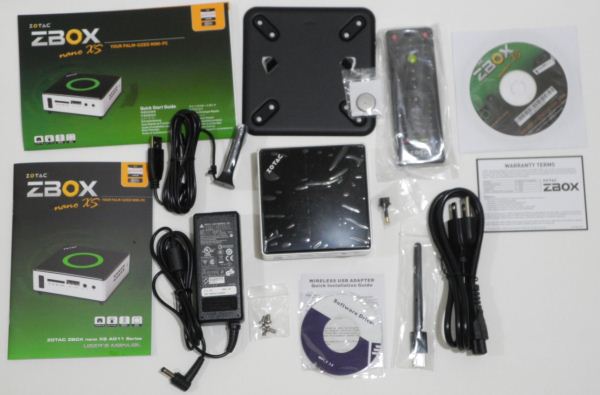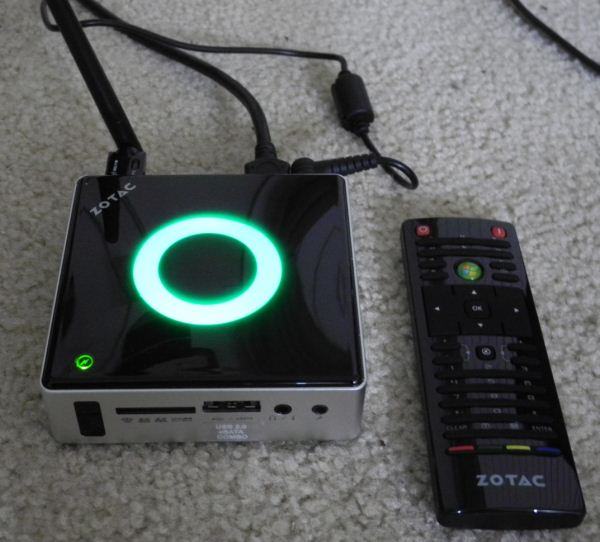Zotac ZBOX Nano XS AD11 Plus: Redefining the Small Form Factor PC
by Ganesh T S on April 11, 2012 5:30 PM EST- Posted in
- Home Theater
- ZOTAC
- Fusion
- HTPC
The ZBOX comes in a small package, about the size one would expect for a mid-range graphics card. In making up for the small size of the PC, Zotac has put in all sorts of add-on peripherals into the package. The external PSU is rated for 65 W. Apart from the main unit, the setup guides, user manuals and driver CDs, the package contained the following:
- VESA mounting plate with mounting screws
- MCE remote with 2 CR2032 batteries
- 65W (19V at 3.42A) AC - DC adaptor
- USB 2.0 based Wi-Fi (150 Mbps 802.11n) adaptor
- mini-Optical SPDIF adaptor
- USB 2.0 based extensible IR receiver (allows users to utilize the MCE remote even when the ZBOX is VESA mounted)
The main unit has a sleek rounded finish and is definitely aesthetically pleasing. The various external features of the unit have already been tabulated in the previous section. The gallery below has some photos of the unit.
The underside of the unit can be easily removed by unscrewing the four rubber risers. This gives access to the SO-DIMM as well as the mSATA slot. These are the user replaceable components. After voiding the warranty, it is possible to take a look at the other side of the board. It is quite surprising that Zotac has managed to put a fan on top of the board in such a small system. Given the space constraints, the fan is indeed short in diameter. When the system isn't being stressed much, the fan is pretty quiet. However, once the fan starts to increase the RPM, the noise dampening is not effective at all. While I would have preferred a fanless system, I do see that the target market for this PC might include people who don't understand the necessity to keep a passively cooled system in a well ventilated location.
After putting the system back together, I proceeded to boot up the system. The BIOS is quite basic, and very similar to what Ian saw in the Zotac Fusion350-A-E review except for a custom background. My main gripe with the BIOS is that there is no way for the users to set the amount of memory to keep allocated to the integrated GPU. It is set to a very inflexible 384 MB.
Once past the BIOS, I went ahead and installed Windows 7 Ultimate x64 off an USB flash drive. The install went smooth, albeit not as fast I would have wanted for a SSD based system. After installation, I found that a number of peripherals were not working (including the Ethernet and the Wi-Fi). All the drivers to be installed were on a couple of CDs, and this was a system with no optical drive. I had to hunt down another machine with an optical drive and then copy over the CD's contents onto a flash drive to proceed with the installation. After this stage, Windows took care of updating itself. It is really irritating to see companies shipping units without optical drives, but still supply drivers on a CD.
The Zotac ZBOX Nano XS AD11 Plus in Operation
(Note that the bright green ring can be turned off in the BIOS)
SSDs are meant to get things done fast on a machine. Reduction in boot time is one of the purported advantages. However, on the ZBOX unit, a Win7 SP1 clean install took around 31 seconds to boot. This is nothing to write home about. In the next section, we will take a look at the general performance metrics.
























43 Comments
View All Comments
tipoo - Wednesday, April 11, 2012 - link
Do any exist in this form factor, or are the joints proprietary? For something like this a large passively cooled heatsink would be nice.DanNeely - Wednesday, April 11, 2012 - link
I don't think there's room for anything much larger. You've only got 1/4" minus the thickness of the baseplate in additional vertical space. You don't have room to expand sideways either, the area oposite to the USB/Ethernet/etc connectors is taken up by the daughterboard with the audio/Sd/eSata headers.gamoniac - Wednesday, April 11, 2012 - link
I have a slightly larger ZBox Nano AD10 with E350. This thing runs hot. I don't passively cooled heat sink would work. Just today, mine shut down again while my wife was using it just for web surfing; this is a long running issue since I had this unit. The small form factor was cute at first but the problem became annoying when it does not do what you bought it for.While it's good to push for smaller form factor, it is even more important that Zotac makes sure that they put out a product that works. On that note, does anyone want to buy a fairly new ZBox Nano AD10 with E350? :(
gamoniac - Wednesday, April 11, 2012 - link
PS: My GPU temp is high as Ganesh's screenshots show in this article. CPU is hot too during normal usage. I even threw in an SSD but that didn't seem to help keeping the temperature down much, so I swapped the SSD out to use somewhere else worthwhile.Matias - Wednesday, April 11, 2012 - link
I agree, I also have an AD10 and it runs waaay to hot!Samus - Thursday, April 12, 2012 - link
For the same price you could build a Pentium G620, Intel Z68 mATX, 4GB DDR3, 128GB Intel SSD, in a SilverStone ML03B chassis that'll fit in beautifully with any receiver, dvd player or other media equipment.It'd be vastly superior in every way. Ridiculously faster, more expandable, quieter, cooler, lower power consumtion (when used with 80+ Bronze PSU) and unfortunately for Zotac, infinitely more reliable.
ZBox Nano's are notorious for overheating, and other than putting them in front of an air conditioner, there is no real way to fix it with such a design. The reviews on Newegg and Amazon have a number of people discussing the shortcomings of this unit with few people saying they'd buy one again.
As usual, DIY trumps all. When a company finds an economical+superior alternative, then its worth AT reviewing it.
Matias - Thursday, April 12, 2012 - link
This DIY setup is like 5 times larger than the Zotacs, keep that in mind. I also build DIY desktops, but for HTPC the small form factor of the Zotac is still unrivaled.DanNeely - Friday, April 13, 2012 - link
The Silverstone case Samus suggested is actually 65 times larger (by volume). It's smallest dimension is the same size as the Zotac's largest...cjs150 - Thursday, April 12, 2012 - link
the problem is that the design is not optimised for fanless operation. What is needed is an after market case which would be a heavy duty heatsink (Hfx, Streacom do these but for full sized mini-itx form). It looks as though even the E-450 just does not have enough power to do the obvious job (as an HTPC) correctly.At the moment the better option is to wait for Trinity ULV or bite bullet and go for a proper mini-ITX board.
Maybe if Intel actually did some proper design of an IGP and fixed the frame rate refresh option that would be best - an i3 but with an AMD IGP is the perfect combination
Zink - Wednesday, April 11, 2012 - link
That mobo sure is cute. Even if it isn't that useful, someone needs to keep pushing new form factors.